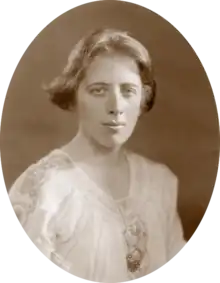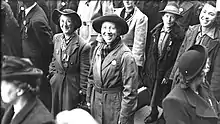Maire Comerford | |
|---|---|
 Comerford, c. 1923 | |
| Born | Mary Eva Comerford 2 June 1893 |
| Died | 15 December 1982 |
| Resting place | Mount Saint Benedict Cemetery in Gorey, County Wexford. |
Máire Aoife Comerford (2 June 1893 - 15 December 1982) was an Irish republican from County Wexford who witnessed central events in 1916-23 and remained a committed supporter of Cumann na mBan until her death. Her memoir of the Irish revolutionary period, On Dangerous Ground, was published posthumously in 2021.[1]
Early life

Comerford was born Mary Eva Comerford on 2 June 1893 in Rathdrum, County Wicklow. Her parents were James Comerford, a flour and corn miller who owned the Comerford Mill, and Eva Mary Esmonde. She had two brothers (Thomas and Alexander) and one sister (Dympna). Her maternal grandfather, Thomas Esmonde had been awarded a V.C. for bravery in the Crimean war in 1854. On his return to Ireland he joined the Royal Irish Constabulary and was promoted to Deputy Chief Inspector.
Her father died when she was 16 and in 1911 she was sent to London to a secretarial school. During this time she stayed in the Ladies Club in Eccles Place. She returned to Ireland to live with her mother in the home of her uncle in Wexford, T. L. Esmonde. Around 1915, her mother rented a house in Courtown, Co Wexford to set up a school.
1916-1922
Comerford was in Dublin during the outbreak of the Easter Rising in Dublin and volunteered to aid Countess Markievicz in St Stephen's Green, but was turned away. She carried despatches for the GPO garrison. She returned to Gorey after the Rising and joined the local Sinn Féin branch where she worked alongside Sean Etchingham.
Comerford supported the prisoners who had been taken in 1916 and the reordering of the Sinn Féin party from 1917. She returned to Dublin shortly before the 1918 General Election, where she worked on Roger Sweetman's election campaign. Sinn Féin won a majority in the election. On 21 January 1919 she attended the Round Room at the Mansion House, witnessing the creation of the First Dail by the 27 TDs present.[2]
Comerford supported the IRA in the Dublin area during the Irish War of Independence. Because they were less likely to be searched, Cumann na mBan members often moved weapons through crowded areas in broad daylight: "Dumps were moved where necessary and I learned from experience that the Lee Enfield service rifle could be carried under my coat without protruding at the bottom if the muzzle was held under my ear".[3] She also helped to run the Irish White Cross, led by the Quaker James Douglas, which aimed to assist civilian war victims by raising money in the United States.[4]
Civil War
Before the Irish Civil War of 1922-23, Cumann na mBan had voted by 419-63 against the terms of the Anglo-Irish Treaty and wanted to maintain the Irish Republic. However this vote was taken after the Treaty had been approved by the Dáil on 7 January.
In June 1922 she managed to escape from the Four Courts during the Battle of Dublin. The war further split the Sinn Féin movement, and in 1923 Comerford was arrested and held at the women's section of Mountjoy Prison. She had been arrested for possession of a revolver. She was held in solitary confinement for three months "because of her defiant attitude".[5] On the 23 March 1923 the female prisoners in Mountjoy were scheduled to be transferred to a separate womans prison - the North Dublin Union (NDU). The prisoners resisted being searched before their transfer and were met with violence. Maire Comerford was badly beaten and received stitches to the head, others were subject to beatings and humiliations and some were thrown down flights of stairs.[6] While being held in NDU Comerford took part in the 1923 Irish Hunger Strikes. 50 women being held in NDU went on hunger strike protesting their continued imprisonment long after the end of the Irish Civil War.[7]
Republican politics
Following the Civil War, Comerford supported Éamon de Valera and his abstentionist Republican candidates, but split with him (as did Mary MacSwiney) when he entered the Dáil in 1927. In 1926 he had established the Fianna Fáil party, which drew off a number of Cumann na mBan supporters and weakened it thereafter. Comerford remained a member of what was from then on generally seen as a committed group which would not compromise in terms of politics on constitutional matters.
In 1935-65, despite their political differences, she worked as a journalist at De Valera's newspaper The Irish Press. During "The Emergency", the Irish Directorate of Military Intelligence was concerned about The Irish Press having Comerford, Brian O'Neill, R. M. Fox, Geoffrey Coulter, and Tom Mullins on its staff.[8]
Later life
In 1967 Comerford worked on the restoration of the Tailors' Hall in Dublin, which had housed Wolfe Tone's nascent republican parliament in the 1790s, with the Irish Georgian Society. In 1969 her book, The First Dáil, was published by Joe Clarke. In later years she felt that Éamon de Valera's suggestion in America in 1919-20 that Ireland's future relationship to Britain would be about the same as that of Cuba to the USA had started the mentality of compromise that had led to the Treaty being signed in 1921.
In the 1970s and up to her death she supported the Provisional Irish Republican Army war in Northern Ireland, in particular its hunger strike campaign. In 1976 she was interviewed for the 'Curious Journey' television documentary with other survivors of the 1914-23 period. These interviews were later published as a book titled Curious Journey. An Oral History of Ireland's Unfinished Revolution (1982).
Comerford worked as a journalist until her retirement in the 1960s. She never married.
Brian Harrison recorded an oral history interview with Comerford, in July 1977, as part of the Suffrage Interviews project, titled Oral evidence on the suffragette and suffragist movements: the Brian Harrison interviews.[9] Comerford discussed Irish nationalism and the women's movement, including the involvement of Hanna Sheehy-Skeffington.
Death and legacy
Comerford died on 15 December 1982, aged 89. She was buried in Mount Saint Benedict Cemetery in Gorey, Co Wexford.
In 2021, her memoir was edited by Hilary Dully and published by Lilliput Press as On Dangerous Ground, a Memoir of the Irish Revolution.[1]
Archive
Comerford's papers are held at two Dublin libraries:
Bibliography
- The First Dáil, January 21st 1919 (1969). Dublin: Joe Clarke.
- Curious Journey. An Oral History of Ireland's Unfinished Revolution (1982). London: Hutchinson. (Interviews with Tom Barry, Maire Comerford, Seán Harling, Seán Kavanagh, David Neligan, John L O'Sullivan, Joseph Sweeney, Brighid Lyons Thornton and Martin Walton)
- On Dangerous Ground, a Memoir of the Irish Revolution (2021). Edited by Hillary Dully. Dublin: Lilliput Press.
References
- 1 2 "Máire Comerford: the last Irish revolutionary to tell her story". The Irish Times. Retrieved 23 February 2023.
- ↑ Dail roll 21 January 1919 Archived 19 November 2007 at the Wayback Machine
- ↑ McCarthy, Cal (2007). Cumann Na mBan and the Irish Revolution. Cork: The Collins Press. p. 131. ISBN 978-1-905172146.
- ↑ "Comerford, Maire (Mary Eva) | Dictionary of Irish Biography". www.dib.ie. Retrieved 23 February 2023.
- ↑ Thorne, Kathleen, (2014) Echoes of Their Footsteps, The Irish Civil War 1922-1924, Generation Organization, Newberg, OR, pg 150, ISBN 978-0-692-245-13-2
- ↑ McCarthy, pg.212.
- ↑ hÉireann, Stair na (13 October 2016). "1923 – A mass Hunger Strike is launched by 424 Republican prisoners in Mountjoy Gaol in protest at their continued detention after the war's end". Stair na hÉireann | History of Ireland.
- ↑ McGarry, Fearghal (May 2002). "Irish newspapers and the Spanish Civil War". Irish Historical Studies. Footnote 23. 33 (129): 73. doi:10.1017/S0021121400015510. S2CID 159331813.
{{cite journal}}: CS1 maint: location (link) - ↑ London School of Economics and Political Science. "The Suffrage Interviews". London School of Economics and Political Science. Retrieved 12 December 2023.
- ↑ "Comerford, Maire, 1893-1982". National Library of Ireland. Retrieved 25 January 2022.
- ↑ "Papers of Máire Comerford". www.ucd.ie. Retrieved 25 January 2022.
- ↑ "Máire Comerford Papers LA18" (PDF). www.ucd.ie. Retrieved 25 January 2022.
External links
- "Unveiling of plaque to name the Riverside Walk - Monday, 17th April 2006 on the occasion of the 90th Anniversary of the Easter Rising 1916". Archived from the original on 27 September 2007.
- "Her opinion on the death of Michael Collins". Archived from the original on 29 September 2007.
- Info on the Tailors' Hall (archived 2013)